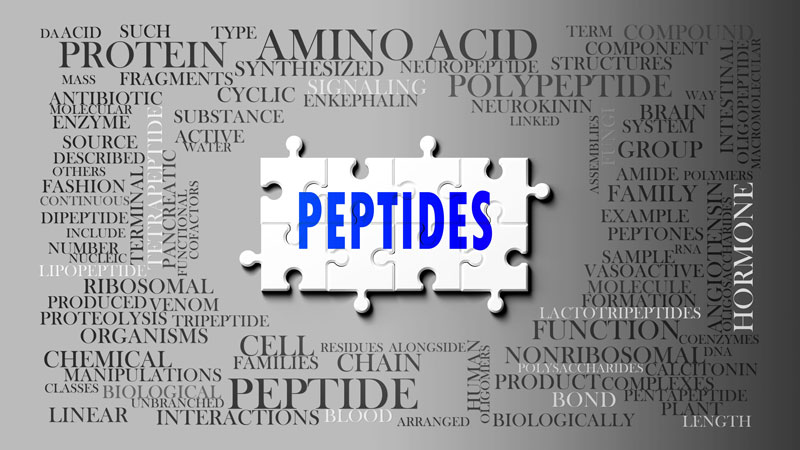Peptide therapy is gaining attention for its potential benefits in various areas of health and wellness. These short chains of amino acids can play significant roles in healing, growth, and vitality. Here’s an overview of some primary advantages and important considerations when it comes to peptide therapy.
Unlike prescription hormone replacement drugs which often provide short-term relief from symptoms associated with hormonal imbalance, peptides provide long-term benefits by helping the body maintain balance and regulate hormones at optimal levels for extended periods of time.
Key Benefits of Peptide Therapy
- Tissue Rejuvenation and Repair: Peptides can facilitate the rejuvenation and repair of tissues, particularly muscle and connective tissues. They have shown promise in treating conditions such as irritable bowel syndrome (IBS) and colitis due to their healing properties. By accelerating the body’s natural repair processes, peptides can help restore function and reduce inflammation in damaged tissues.
- Enhanced Metabolism and Growth: Peptides are crucial in boosting metabolism and promoting the growth of various tissues. This metabolic enhancement can lead to improved fat loss and muscle growth, among other physiological benefits. For individuals seeking to enhance their physical fitness or recover from injuries, peptide therapy can be a valuable tool.
- Increased Longevity and Vitality: Some peptides are being explored for their potential to extend lifespan. While this area is still experimental, there is evidence suggesting that certain peptides can enhance overall vitality. This includes improvements in mood and libido, which are essential components of a healthy, active lifestyle.
Types of Peptides Used in Therapy
Peptide therapy encompasses a variety of peptides, each tailored to specific therapeutic needs and benefits. Here’s an expanded overview of the different types of peptides used in medical and wellness settings:
Growth Hormone-Releasing Peptides (GHRPs)
- Sermorelin: This peptide is FDA-approved for treating growth hormone deficiency, particularly in children with short stature. It also finds off-label use in stimulating growth hormone pathways for various health benefits, such as improved muscle mass and recovery.
- Tesamorelin and CJC 1295: These synthetic peptides are designed to stimulate growth hormone secretion. Tesamorelin is particularly effective in reducing visceral fat, especially in HIV patients, while CJC 1295 is known for its long-acting effects, making it a popular choice for sustained growth hormone release.
- Ipamorelin and Hexarelin: Both peptides are potent stimulators of growth hormone release. Ipamorelin is noted for its selective action, minimizing unwanted side effects, whereas Hexarelin is highly effective but can increase prolactin levels, leading to potential issues like reduced libido and fluid retention.
- GHRP-2, GHRP-6, and MK-677: These peptides significantly boost growth hormone levels. However, they can also raise cortisol levels, which may have various health implications, including stress response and metabolic changes.
Healing and Regenerative Peptides
- BPC-157: Known for its healing properties, BPC-157 accelerates the repair of tissues such as tendons and ligaments. This peptide mimics a naturally occurring gut peptide involved in wound healing, making it effective for injury recovery.
- Thymosin Beta-4 (TB-500): This peptide promotes healing and regeneration by enhancing cell migration and reducing inflammation. It is particularly useful for healing acute injuries and improving recovery times in athletes.
- AOD-9604: Originally developed as an anti-obesity drug, AOD-9604 mimics the fat-burning activity of human growth hormone (HGH) without the adverse effects on blood sugar levels. It also aids in cartilage repair and regeneration.
Cosmetic and Skin Health Peptides
- Melanotan II: This peptide is used to enhance tanning by stimulating melanocyte production. It can also affect mood and libido. However, it must be used cautiously due to potential side effects like nausea and skin flushing.
- Palmitoyl Pentapeptide-4 (Matrixyl): Commonly used in anti-aging skincare products, this peptide helps reduce the appearance of wrinkles by promoting collagen production and skin repair.
- Argireline (Acetyl Hexapeptide-8): Known as a “Botox in a bottle,” Argireline reduces fine lines and wrinkles by inhibiting neurotransmitter release, which prevents muscle contraction.
Metabolic and Cognitive Enhancing Peptides
- GLP-1 Agonists (e.g., Semaglutide): These peptides are used in managing type 2 diabetes and obesity by enhancing insulin secretion and promoting weight loss. They also show potential in improving cognitive function and neuroprotection.
- Dihexa: A promising peptide for cognitive enhancement, Dihexa is believed to improve synaptic connectivity and promote neurogenesis, making it a potential therapeutic agent for neurodegenerative diseases like Alzheimer’s.
- Follistatin: This peptide inhibits myostatin, a protein that limits muscle growth, thereby enhancing muscle mass and strength. It also shows potential in improving metabolic health and reducing inflammation.
Safety Concerns and Risks
While peptide therapy can offer significant benefits, it also comes with potential risks and safety concerns:
- Contamination and Purity: Peptides from non-reputable sources may be contaminated or impure, potentially leading to immune reactions or other health issues. Ensuring peptides are obtained from reputable pharmaceutical companies or compounding pharmacies is crucial.
- Adverse Reactions and Overdose: Even peptides with high safety profiles, like BPC-157, can cause complications if not dosed properly. Long-term or high-dose usage can lead to unforeseen adverse effects, underscoring the importance of adhering to prescribed doses.
- Regulation and Approval Issues: Many peptides are used off-label for conditions other than their approved uses, which can pose risks if their effects are not well understood. Peptides sourced from the gray or black market may lack regulatory scrutiny, increasing the risk of adverse effects.
- Physical Alterations and Long-Term Consequences: Peptides affecting growth hormones can lead to significant physical changes, such as altered body structure or an increased risk of tumor growth due to elevated growth factors. These changes necessitate careful management under medical supervision.
Recent Research Insights
Recent research has highlighted several important aspects of peptide therapy:
- Safety and Sources: Obtaining peptides through a board-certified physician ensures they are pure and safe, avoiding the risks associated with unregulated sources.
- Types and Effects: Different peptides, like those used for growth hormone enhancement (Sermorelin, Tesamorelin), have specific effects and potential side effects. Proper sourcing and dosing are critical to minimize risks.
- Complexity and Pleiotropic Effects: Peptides often have multiple effects, making their therapeutic use complex. This complexity requires expert guidance to navigate potential interactions and side effects.
Overall, peptide therapy offers promising benefits but must be approached with caution and professional oversight to ensure safety and efficacy. By understanding the specific functions and benefits of various peptides, individuals can make informed decisions about incorporating peptide therapy into their health and wellness regimen.
If you’re interested in Peptide Therapies, Peak Male Institute recommends a fully integrated approach, addressing medical and lifestyle factors to successfully and permanently lose weight and improve your health. Peak Male Institute also offers Telemedicine Appointments along with their highly effective treatment options. Contact our medical specialists today to see what programs are available to get you started on a remote option treatment plan and begin Transforming Your Life today. Call: (941) 759-5955 or Email us to get started.
References:
- Sermorelin, Tesamorelin, and CJC 1295:
Walker, R. F. (2006). Growth hormone-releasing peptides. *Clinical Pharmacology & Therapeutics*, 80(5), 403-411.
Falutz, J., Allas, S., Blot, K., et al. (2007). Metabolic effects of a growth hormone-releasing factor in patients with HIV. *The New England Journal of Medicine*, 357(23), 2359-2370. - Ipamorelin and Hexarelin:
Ghigo, E., Arvat, E., Gianotti, L., et al. (1999). Hexarelin in clinical practice. *Journal of Endocrinological Investigation*, 22(5), 350-356.
Svensson, J., Bengtsson, B. A. (2001). Growth hormone-releasing peptides: clinical studies. *Hormone Research in Paediatrics*, 56(Suppl 1), 58-61. - BPC-157:
Šušak, L., Strac, D. S., Hrelec, D., et al. (2020). BPC 157 and its effects on healing. *Current Pharmaceutical Design*, 26(26), 3111-3119. - Thymosin Beta-4 (TB-500):
Sosne, G., Kleinman, H. K. (2015). Thymosin beta 4 peptide therapy. *International Journal of Molecular Sciences*, 16(3), 4891-4907. - Melanotan II:
Hadley, M. E., Dorr, R. T. (2006). Melanocortin peptide therapy. *Peptides*, 27(2), 317-322. - Palmitoyl Pentapeptide-4 (Matrixyl):
Lintner, K., Peschard, O. (2000). Anti-aging peptides. *International Journal of Cosmetic Science*, 22(2), 133-146. - GLP-1 Agonists (e.g., Semaglutide):
Drucker, D. J. (2018). Mechanisms of action and therapeutic application of GLP-1 agonists. *Cell Metabolism*, 27(4), 740-756.
Lovshin, J. A., Zinman, B. (2010). GLP-1 receptor agonists in the treatment of type 2 diabetes. *Diabetic Medicine*, 27(7), 712-718. - Dihexa:
Hamilton, B. A., Garcia, T. S., Zielinski, B. A., et al. (2019). Dihexa peptide therapy. *Neuropharmacology*, 157, 107670. - Follistatin:
Lee, S. J., McPherron, A. C. (2001). Follistatin and muscle growth regulation. *Annual Review of Cell and Developmental Biology*, 17(1), 517-543. - General Peptide Therapy:
Bowers, C. Y. (1999). Peptide therapeutic advances. *Endocrine Reviews*, 20(4), 507-515.
Zandman-Goddard, G., Shoenfeld, Y. (2005). Peptide therapies in autoimmune diseases. *Journal of Clinical Immunology*, 25(3), 238-245.
These references provide a foundation for understanding the scientific and clinical background of peptide therapy, its benefits, and associated risks. For specific medical advice and treatment options, it is always recommended to consult with a healthcare professional.




